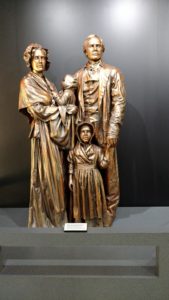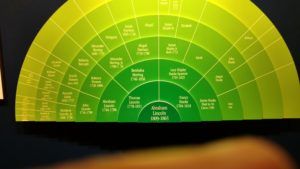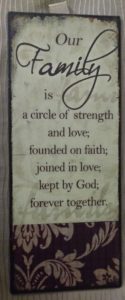Much to catch up on. Passed 8000 miles yesterday. Getting a bit lower gas mileage. Probably due to a slight uphill grade as we head north and west. Also the prevailing western winds on the plains have an effect. After finishing our activities in Iowa and traveling across Nebraska, we are now in South Dakota, our 18th state for this trip.
Monday and Tuesday were days with a focus on Peg’s family both living and past. We spent time with 2 aunts and 3 cousins. We also visited the places where she and her father lived part of their lives and where her grandparents and great grandparents lived and farmed. We also included a stop at the local cemetery in Granville, Iowa, and the place in town where a Veterans Memorial is being constructed.
10 more National Parks in the past few days for a total of 33 on this trip.
On Tuesday we visited a beautiful Lewis and Clark Interpretive Center along the River in Sioux City Iowa. We always watch the park films when we go to these places. The one at this place was quite beautifully done. An actor playing William Clark recounted many aspects of the Lewis and Clark Journey almost entirely with quotes directly from their journals. Sioux City is the site of the only death of a member of the Lewis and Clark Expedition. The film did a wonderful job of giving an overview of the journey with a focus on Sargent Floyd’s death. I learned that after his death, Lewis and Clark allowed the men to vote on who among their number would replace Floyd as a Sargent, with leadership responsibilities for the remainder of the trip. This may have been the first use of a democratic style of voting west of Mississippi.
On Wednesday we saw Niobrara National Scenic River. A beautiful place in upper central Nebraska. Looks like a wonderful recreation area and a place worth protecting from overdevelopment. However, as I think about what rises to the level of being a “National Park”, I wasn’t caught by anything compelling for this place.
On Thursday we revisited previously visited parks of Chimney Rock and Scottsbluff National Monument. These are points passed by many 100’s of thousands of travelers heading West on many routes central to our country’s history. These points were about one third of the way west for the many travelers to the Oregon territory. Trails through these points include: the Oregon National Historic Trail, the Mormon National Historic Trail, the California National Historic Trail (during the gold rush), and the Pony Express National Historic Trail.
Today, Friday, we visited both the Agate Fossil Beds National Monument, and Mount Rushmore National Memorial.
The visit to Agate Fossil Beds provoked a lot of thoughts for me. I have always been interested in the “process” of how things happen. The Museum did a very nice job of explaining the process of fossilization in this particular area. The process which resulted in some amazingly large finds of fossilized bones from 20 million years ago involved many changes in environment over time. There were periods of lush growth on the primal prairies of the area, followed by periods of drought, and periods of flood, and then many repeats of those same events. We would not have these bones from which we can learn of this history without these processes. But more importantly, life on earth would not have evolved as it did without these processes. Life, from the beginning, has always expanded in quantity during times of plenty and then struggled to survive and to adapt in more difficult times. This process is at the core of the evolution of all life on earth.
I think the same processes of calm and struggle apply to human history in general and specifically to the history of human evolution of social structures. I have been influenced by the book “Generations” which analyzes American History from the Mayflower to the present through the lens of the common experiences of different generations of people throughout that time period. The book lays out a theory of cyclical periods of spiritual awakenings and secular crises. In each period of crisis, American society is split to the point of breaking by one or more issues (Should we become an independent country? Should we allow slavery to continue? Should government take responsibility for the social welfare of its people?). After a period of crisis that question is substantially resolved and the country moves on for some time based on a new understanding of the relationship between the people and their government. These periods of extreme crisis seem to occur at about 80 to 90 year intervals.
When I think about some of the current events in our country I see a similar level of extreme conflict to that which has occurred in the past. There seems to be at least 2 mutually exclusive views of the world and almost everyone has adopted one or the other of those views. There seems to be almost no valuing of moderation, compromise, or respect for alternative points of view in our current culture. It feels like our country is in crisis although it is beyond my skill to identify in any convincing way exactly what the crisis is about.
In looking at this state of crisis my view of history as being subject to periodic cycles is both reassuring and disturbing. It is reassuring because we, as a country, have survived at least 4 such previous crises. Not only survived, but become a better place to live and prosper after each such crisis. It is disturbing because, in each such instance, the crisis has only been resolved after an event or period of bloodshed and/or extreme suffering. I hope we can manage to make it through our current crisis without such extremes as the King Phillips War, the Revolutionary War, the Civil War, or the Great Depression and World War II. I don’t see how the extreme divisiveness prevalent in our current culture is likely to dissipate absent some extreme event, but I can only hope such a way can be found.
Again I look at the history of fossils and evolution at the Agate Fossil Beds as a point of comparison. Despite many crises and struggles, life has always found a way to adapt and progress. I hope in our social realm we can do the same without leaving too many of our bones behind as fossils.
 At the Lincoln Birthplace I even found some displays that continue some of the themes of this trip, family and ancestry. There was a beautiful sculpture of the Lincoln family at the time he was a baby and very nice display of Abraham Lincoln’s known ancestry.
At the Lincoln Birthplace I even found some displays that continue some of the themes of this trip, family and ancestry. There was a beautiful sculpture of the Lincoln family at the time he was a baby and very nice display of Abraham Lincoln’s known ancestry.
 First off for the day we found a tiny cemetery in the middle of the farmlands east of Auburn, Indiana, Cosper cemetery. A year or so ago I would not have thought to stop here. However, in the past year, I had a break through on one brick wall in my family history research. I have known for about 1
First off for the day we found a tiny cemetery in the middle of the farmlands east of Auburn, Indiana, Cosper cemetery. A year or so ago I would not have thought to stop here. However, in the past year, I had a break through on one brick wall in my family history research. I have known for about 1 0 years, not too long after I discovered who my father was, that one of my great grandmothers was Catherine Francis Miller. And I had some hints as to her parents, John Miller and Barbara Wappes. But that was the end of my information. Then through some connections through my online family trees I made contact with a cousin and found enough information to go back a bit more. Catherine’s father was Johnathon G Miller, and he was born in 1832 in Pennsylvania and died in 1922 in Idaho. Also, his parents were Eli Miller and Catharine Eva Whisler. They were both born in Pennsylvania, but later moved to Indiana and lived, died, and were buried, in De Kalb county Indiana. Today we found their gravesite and were able to stand in fields where they had lived.
0 years, not too long after I discovered who my father was, that one of my great grandmothers was Catherine Francis Miller. And I had some hints as to her parents, John Miller and Barbara Wappes. But that was the end of my information. Then through some connections through my online family trees I made contact with a cousin and found enough information to go back a bit more. Catherine’s father was Johnathon G Miller, and he was born in 1832 in Pennsylvania and died in 1922 in Idaho. Also, his parents were Eli Miller and Catharine Eva Whisler. They were both born in Pennsylvania, but later moved to Indiana and lived, died, and were buried, in De Kalb county Indiana. Today we found their gravesite and were able to stand in fields where they had lived. From Cosper we moved east and north toward Cleveland. But first a stop at a relatively unknown national park,
From Cosper we moved east and north toward Cleveland. But first a stop at a relatively unknown national park, 



 At the end of the day today the people I now can truly identify as “family” gave us a gift and made us promise not to open it til we were back at our hotel. We followed instructions and a good thing too. I don’t think I could have safely driven for awhile after opening their beautiful gift. Sometimes the power of words is just amazing. Obviously the word of the day is family. These people, my sister, and her children and grandchildren are no doubt by family. I am so glad we decided to spend three days here to meet and get to know them. At first I would have described them as family but it would just have been a word. After three days together, sharing stories, sharing pictures, sharing food, sharing an outing to a beautiful park, sharing mutual interests in history, in computers, in puzzles, in cooking, in the education of children among other things, the word “family” has real meaning. These are people I feel at home with, who I instinctually feel I could trust and rely on if needed.
At the end of the day today the people I now can truly identify as “family” gave us a gift and made us promise not to open it til we were back at our hotel. We followed instructions and a good thing too. I don’t think I could have safely driven for awhile after opening their beautiful gift. Sometimes the power of words is just amazing. Obviously the word of the day is family. These people, my sister, and her children and grandchildren are no doubt by family. I am so glad we decided to spend three days here to meet and get to know them. At first I would have described them as family but it would just have been a word. After three days together, sharing stories, sharing pictures, sharing food, sharing an outing to a beautiful park, sharing mutual interests in history, in computers, in puzzles, in cooking, in the education of children among other things, the word “family” has real meaning. These are people I feel at home with, who I instinctually feel I could trust and rely on if needed. While we could not do a sampling of multiple sandwich places we could enjoy one from an iconic Chicago institution: Portillo’s Hot Dogs & Barnelli’s Pasta Bowl. We were only able to sample a couple items from an amazing menu. And everything we tried truley was amazing. We will definitely be making another stop at a Portillo’s the next time we find ourselves anywhere near Chicago.
While we could not do a sampling of multiple sandwich places we could enjoy one from an iconic Chicago institution: Portillo’s Hot Dogs & Barnelli’s Pasta Bowl. We were only able to sample a couple items from an amazing menu. And everything we tried truley was amazing. We will definitely be making another stop at a Portillo’s the next time we find ourselves anywhere near Chicago.